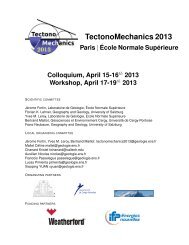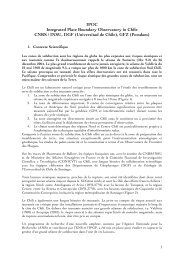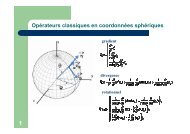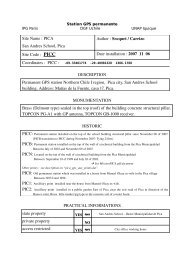PDF file - Laboratoire de Géologie de l'Ecole normale supérieure - Ens
PDF file - Laboratoire de Géologie de l'Ecole normale supérieure - Ens
PDF file - Laboratoire de Géologie de l'Ecole normale supérieure - Ens
You also want an ePaper? Increase the reach of your titles
YUMPU automatically turns print PDFs into web optimized ePapers that Google loves.
SIMONS ET AL.: GPS MEASUREMENTS IN S.E. ASIA TO REFINE SUNDALAND MOTION X - 3<br />
work was re-measured by ENS in 2000. These 3 additional networks<br />
increase the available GPS points in this region by 15.<br />
In Malaysia, (Region 2 in Fig. 1 the inclu<strong>de</strong>d Malaysia Active<br />
GPS System (MASS) consists presently of 17 permanent GPS<br />
tracking stations situated at strategic locations, some at ti<strong>de</strong> gauge<br />
stations. The MASS network was setup by the Department of Survey<br />
and Mapping, Malaysia (DSMM) at the end of 1998. The<br />
MASS network has a good spacing on both the Peninsula and East<br />
Malaysia. While the largest part of Malaysia is located on the stable<br />
part of Sundaland, the network is very suited to investigate any intrablock<br />
<strong>de</strong>formations in Malaysia, especially near/in the Sundaland<br />
boundaries in the eastern part of East-Malaysia (Sabah province).<br />
Three full years of permanent GPS data (1999-2001) were inclu<strong>de</strong>d<br />
in this paper, as well as 2-3 weeks of MASS data in 1998, 2002 and<br />
2003. In this region, the addition of the MASS network increases<br />
the number of available geo<strong>de</strong>tic points from 5 to 22.<br />
The island of Sulawesi, Indonesia, together with the surrounding<br />
region (Region 3 in Fig. 1, is more complex from a geodynamic<br />
viewpoint [Walpersdorf et al., 1998; Simons et al., 2000;<br />
Vigny et al., 2002]. Therefore the existing GEODYSSEA network<br />
was most <strong>de</strong>nsified here and re-measured yearly since 1996. The<br />
observed network also inclu<strong>de</strong>s 2 fault transects (Palu-Koro and the<br />
Gorontalo fault). Since 1999 permanent stations have also been installed<br />
in Sulawesi, mainly to study the behavior of the Palu-Koro<br />
fault (at present 6 stations), in both east-west and north-south direction.<br />
Although all Sulawesi GPS network data was processed along<br />
with the other data on S.E. Asia, a <strong>de</strong>tailed treatment of the results<br />
for Sulawesi is beyond the scope of this paper. Hence, mainly the<br />
motion of the western part of Sulawesi with respect to Sundaland<br />
will be discussed later on. The Sulawesi GPS network was <strong>de</strong>nsified<br />
from the original 8 GEODYSSEA sites in 1994, up to more than 30<br />
in 2003, plus an additional 25 fault transect points.<br />
Since 1997, 3 new sites (NTUS, BAKO and PIMO) from the<br />
IGS became operational in S.E. Asia. These sites have also been<br />
inclu<strong>de</strong>d in the network <strong>de</strong>scribed here. The BAKO site was also<br />
observed as part of the GEODYSSEA network, and the velocity<br />
estimates of these IGS sites were not constrained to those of ITRF<br />
solution of 2000. The time series inclu<strong>de</strong>d for these sites in the<br />
ITRF-2000 solution are relatively short, and hence the velocity estimates<br />
given are not sufficiently accurate for our study. Finally, data<br />
was inclu<strong>de</strong>d from 1 permanent site in Sumatra, Indonesia.<br />
In total, data from about 100 (125 including Sulawesi fault transect<br />
points) GPS points in South and South-East Asia was uniformly<br />
(re)processed, along with an additional data set of about 30 IGS stations.<br />
A summary of the available GPS network sites is given in<br />
Table 1.<br />
The campaign-style GPS data from the Asia Pacific Regional<br />
Geo<strong>de</strong>tic Project (APRGP), which is also available for S.E. Asia<br />
since 1997, was not inclu<strong>de</strong>d in this paper. Near almost all APRGP<br />
sites located on Sundaland, the GPS database used in this paper contains<br />
permanent GPS data. In addition tests conducted with this part<br />
of the APRGP data indicate that the quality of the data (contributed<br />
separately by each Asian APRGP participant) is not always consistent<br />
and sometimes noisier. This can also be noticed in Socquet et al.<br />
[2003, subm.] where 1997-2000 APRGP data on Indochina was inclu<strong>de</strong>d<br />
to a GPS network similar to Table 1, and relatively higher<br />
velocity residuals with respect to Sundaland at these APRGP sites<br />
can be observed.<br />
Because one of the goals of this paper is to present the velocity<br />
estimates in ITRF-2000, a number of permanent IGS GPS stations<br />
nee<strong>de</strong>d to be inclu<strong>de</strong>d. Previous experience with mapping local networks<br />
in S.E. Asia into ITRF, has shown that if only regional IGS<br />
stations are selected the mapping may not always be optimal, and<br />
position, and hence velocity errors may occur. The main reason is<br />
that even today, the available IGS network with valid ITRF-2000 solutions<br />
in S.E. Asia is still limited. A number of new IGS sites in the<br />
region have become available since 1996, but their time series are<br />
relatively short, and the data quality sometimes lower than average<br />
(e.g. IISC, GUAM, LHAS, NTUS and BAKO). Moreover, some<br />
stations have been affected by nearby earthquakes (e.g. COCO),<br />
and hence they don’t always fit the linear velocity trend given by<br />
ITRF, nor are official position jumps ma<strong>de</strong> available. Some stations<br />
had such short time series at the time they were inclu<strong>de</strong>d in an<br />
ITRF solution, that their listed coordinates and velocity estimates<br />
were much less accurate (e.g. KARR in ITRF-97 and PIMO in<br />
ITRF-2000). Because ITRF gives a velocity estimate together with<br />
position at a certain reference epoch (01-01-97 in the last two ITRF<br />
solutions), any errors in the predicted position become larger as the<br />
analyzed GPS data lies further away from the actual time series<br />
used in ITRF-2000. This might not always become clearly visible<br />
in the mapping process, because with few regional IGS sites available,<br />
part of the position misfits can be absorbed by the Helmert<br />
transformations, which are commonly used in the transformation of<br />
network solutions.<br />
If besi<strong>de</strong> regional IGS stations, also a number of well <strong>de</strong>termined<br />
global IGS sites are inclu<strong>de</strong>d in the analysis, the above mapping<br />
problems can be avoi<strong>de</strong>d. Furthermore, some of these inclu<strong>de</strong>d<br />
IGS stations can be exclu<strong>de</strong>d from the mapping process,<br />
and used to check/validate the quality of the ITRF transformation<br />
and/or provi<strong>de</strong> more accurate ITRF velocities for these sites in the<br />
analyzed time period. Therefore, IGS data from 14 regional and<br />
17 global stations (Fig. 2) were retrieved from the IGS databases<br />
(http://igscb.jpl.nasa.gov, [Beutler et al., 1994]). The global IGS<br />
sites were selected upon their availability from 1994 until the end<br />
of 2003, and because the majority of them are ’long-running’ permanent<br />
IGS stations. This ensures that these sites have very well<br />
<strong>de</strong>termined coordinates and velocity estimates, with the most recent<br />
ones provi<strong>de</strong>d by ITRF-2000 (http://lareg.ensg.ign.fr).<br />
3. GPS Data Analysis<br />
In this section the results of the GPS data analysis with the<br />
GIPSY-OASIS II v2.6.1 [Blewitt et al., 1988] software are discussed.<br />
The software inclu<strong>de</strong>s a processing method that allows permanent<br />
GPS networks (up to 100 stations) to be processed in relatively short<br />
time periods, including ambiguity fixing for the whole network.<br />
For the complete data set from 1994 to 2003, daily fiducialfree<br />
network solutions were computed with the GIPSY precise<br />
point positioning (PPP) strategy. With this strategy, each station<br />
can be solved for individually, using precise (JPL) satellite orbits,<br />
satellite clocks and corresponding earth rotation parameters<br />
(ftp://si<strong>de</strong>show.jpl.nasa.gov). Because the orbits and clocks are held<br />
fixed in this technique, all correlations among the different stations<br />
are not explicitly computed. Therefore a network can be processed<br />
in a much more computationally efficient way, as opposed to the<br />
traditional technique where the complete network is processed simultaneously.<br />
The individual PPP station coordinate solutions were computed<br />
using the ionosphere-free linear combination of the zero-differenced<br />
GPS phase and pseudorange data at 5 minute intervals with an elevation<br />
cut-off angle of 15 <strong>de</strong>grees. To account for tropospheric effects,<br />
the zenith path <strong>de</strong>lay (using Niell’s mo<strong>de</strong>l [Niel, 1991]) and gradients<br />
are estimated at each time interval. If required, the <strong>de</strong>fault<br />
apriori value of the wet tropospheric <strong>de</strong>lay (10 cm) and the apriori<br />
station coordinates are iterated upon. Data from GPS satellites<br />
that were un<strong>de</strong>rgoing maintenance during part of the processed day<br />
(ftp://tycho.usno.navy.mil/pub/gps/) were removed. Ocean loading<br />
parameters for all site locations were obtained from H.-G. Scherneck<br />
and M.S. Bos (http://www.oso.chalmers.se/˜loading/[Scherneck,<br />
1991]) and ocean loading mo<strong>de</strong>ling was applied to each site in<br />
the network. Finally, because different antennae were used in<br />
the network, the NGS relative antenna phase center corrections<br />
(http://www.ngs.noaa.gov/ANTCAL [Ma<strong>de</strong>r, 1998]) were applied.<br />
In previous analyses, the IGS antenna phase center corrections<br />
[Rothacher and Ma<strong>de</strong>r, 1996] were used. Unfortunately, the GPS<br />
network in this analysis contains GPS antennae that were not inclu<strong>de</strong>d<br />
in the original official table provi<strong>de</strong>d by IGS (igs01.pcv).<br />
As these new GPS antennae became available, IGS inclu<strong>de</strong>d the<br />
NGS antenna phase center corrections for most of these antennae.<br />
However, differences can be observed between the IGS and NGS<br />
tables for some (ol<strong>de</strong>r) antenna types also used in this network.






